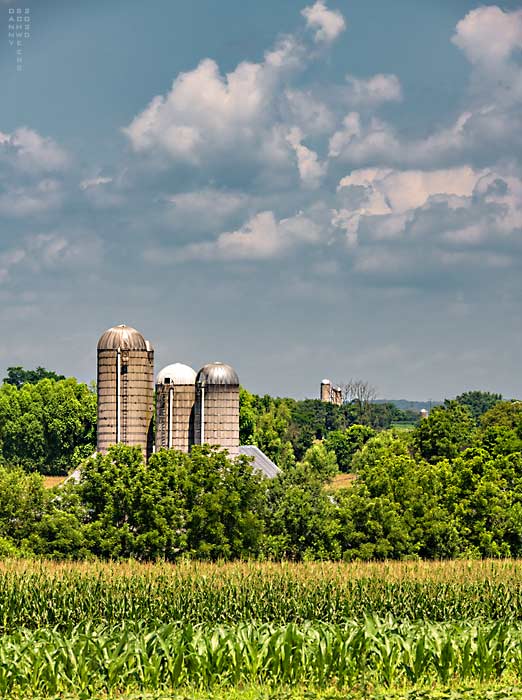Photo Prayer 2020-30 -- Amish Farm Silos
Acidification through anaerobic fermentation — that is one way of understanding the silos we so readily associate with Amish farms. Maize, sorghum, and other cereals are harvested whole, the entire plant cut into half-inch pieces that then fill air-tight silos 35-to-40 feet tall. Within two weeks, the carbohydrates ferment and acidify, making the silage more mildew resistant and more digestible by the cattle, sheep, and horses that will be kept alive through the coming winter months. Who, living for today, being in the moment, plans this far ahead? Not me! I hardly know what I will be doing an hour from now, but I can learn, can’t I? Can’t we?
Photograph of farm silos in Lancaster County, Pennsylvania.
Click here to see more photos of Amish farm country.
Photo and text copyright 2020 by Danny N. Schweers.
You can subscribe to these as they are created, and comment.
Comments
Burley wrote:
Thanks, I think you will know what you will be doing next week -- emailing another beautiful photo prayer. Burley
Hugh wrote:
Thanks! Wonderful info.
John wrote:
Great layers in the photo. Two kinds of crop in the foreground, then trees, farm #1, more trees, farm #2, hills, clouds, sky! I imagine their silos get layered too but also never heard of the anaerobic fermentation process. Wonder how they keep it from going too far? [Danny replied: There is only one crop there, John, corn, in different stages of maturity. The fermentation process runs out of fuel. That’s what keeps it from going too far. When there is nothing left for the bacteria to digest, the process ends. Life is short for bacteria!]
James wrote:
Wonderful photo!
• Am I right to interpret you are critiquing your “living in the moment” and wishing to learn other. Yet I believe it is said to be wise to learn to live in the moment. What gives? [Danny replied: Yes, Jim, I am questioning living in the moment to the extent that it stops us from planning.]
• By contrast I live in mostly chaotic moments dominated by past and future. One example: we are reading and arguing now over how to make a proposal - due in October - that, if successful, would start in 2021 for 5 years…. And it is invigorating yes, but also anxiogenic, neurotic as can be.
• Finally, I note that the silage - after microbial digestion - will contain, among other things, abundant alcohol (EtOH, ethanol) so those livestock may spend the winter very happy indeed. Maybe that is the lesson for us? ; )
Scott wrote:
I enjoy the general color and composition. But since Jim has tickled my mind, I suppose there is an interesting play that I see between nature (the trees & sky), human modified nature (the corn), and human hard science beyond nature (the silos).
Tom wrote:
Wow, thanks for the science behind silos. I knew basically that they were for storing food for animals, but I didn't know how they work.
